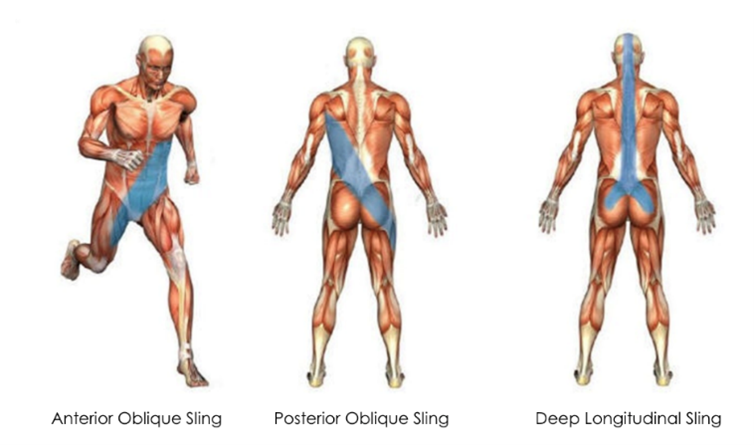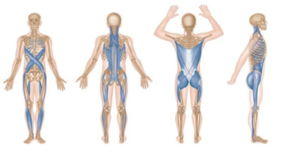Have you ever noticed that the body works powerfully in diagonals and when utilizing the opposite arm and leg. For example, this is seen when kicking a soccer ball, running, swimming, or hitting a golf swing.
Myofascial slings are made up of muscles, facia (connective tissue) and ligaments which work together to create harmonious movement and stability. When working optimally, these structures interact together to safely transfer load throughout the body to optimize power, strength and speed. If weak spots within the sling are present due to injury or repeated posture, this can create dysfunction, pain and malalignment with suboptimal function in the long term.
There are four different major slings in the body that all revolve around the primary sling called the torso. The torso is a cylindrical structure with the diaphragm at the top, pelvic floor at the bottom, multifidus on the back and transverse abdominus wrapped around the middle like a corset. This structure provides stability to the spinal segments and provides attachment sites for the major slings of the body.

Major Slings of the Body
- ANTERIOR OBLIQUE SLING
- POSTERIOR OBLIQUE SLING
- DEEP LONGITUDINAL SLING
- LATERAL SLING
- Anterior Oblique Sling: diagonal line connecting the rib cage on one side to the opposite groin/ inner thigh.
Exercises that target this sling: lunge and rotation, oblique curl up, side plank with ball squeeze, woodchop.
- Posterior Oblique Sling: diagonal line connecting the back of the shoulder on one side and glutes on the opposite side.
Exercises that target this sling: glute bridge with arm pulldown, lunge and row, four-point kneeling superman.
- Deep Longitudinal Sling: straight line connecting the back and spinal muscles to the hamstrings on the same side.
Exercises that target this sling: single leg bridge, deadlift, kettlebell swings, cobra.

- Lateral Sling: diagonal line connecting the glutes on one side and the inner thigh muscles on the opposite side.
Exercises that target this sling: clam, side kick, step up, single leg squat.

Training the sling systems of the body is an excellent way to create and maintain functional movements, strength, and awareness. Although the ‘train by muscle group’ approach is more common, this doesn’t effectively provide overall movement quality. Completing a combination of training including isolated, compound, bilateral and multi-plantar movements is most beneficial if your goal is to ensure you are moving well across all planes of motion in addition to maintaining strength and muscle size.




